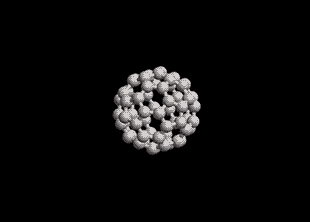Physicists for the first time studied in detail the dynamics of the destruction of fullerene C 60 under the influence of ultrashort pulses of x-ray radiation. It turned out that the perturbation leads to the formation of significant ionization of the molecule, but it breaks after a noticeable amount of time, and among the fragments there are many neutral carbon atoms. The results are important for the interpretation of most methods for determining molecular structures using x-rays.
In many fields of science, for example, in biochemistry, knowledge of the structure of complex molecules, usually organic, is required from which the exact function of a substance can be determined. For the most developed study method, X-ray diffraction analysis, it is necessary to synthesize a solid crystal of a substance, illuminate it with X-ray radiation and analyze the resulting diffraction pattern. The crystallization of many substances, however, remains a difficult task, which is why scientists are trying to develop new approaches.
The work of physicists from the USA, Europe, and Japan, led by Nora Berrah from the University of Connecticut, examined in detail the possibilities of a method for determining the structures of molecules based on their destruction by laser pulses. As a target, scientists chose the fullerene C 60 – one of the simplest molecules with a closed three-dimensional structure. The bonds between the atoms in it are formed into regular pentagons and hexagons – something like on the classic Adidas Telstar soccer ball. C 60, on the one hand, is quite simple (symmetrical and consists of one type of atom), and on the other hand, it strongly resembles organic compounds in which bonds between carbon atoms form the basis of the structure.
Scientists combined experiments with numerical simulation of the interaction. The authors were able to observe the process of molecular decay with a temporal resolution of the order of 10 femtoseconds. The process was started by an X-ray laser pulse with a duration of about 20 femtoseconds obtained with the Linac Coherent Light Source (LCLS) at the SLAC National Accelerator Laboratory in the USA.
It turned out that a pulse knocks out an electron at about every fifth atom, but this does not lead to an instantaneous explosion of fullerene: it collapsed more slowly than the researchers expected. The decay began after several tens of femtoseconds, and the whole process took about 600 femtoseconds, which is less than a trillionth of a second, but significantly longer than the pulse duration and can be confidently measured using modern equipment.
“What is happening cannot be called a real explosion. Instead, fullerene breaks up relatively slowly, says Robin Santra of DESY, Germany. Carbon atoms gradually evaporate, moreover, there are much more neutral atoms than charged ones, which is very surprising. Usually about 25 neutral and only 15 charged atoms fly out of a molecule, and the rest form groups of several.”
The results of this work will be useful in the analysis of other methods for studying molecules related to x-ray radiation. In particular, protein crystals often evaporate under the influence of a flash of energy electromagnetic waves, and a detailed understanding of the dynamics of this process will help substantiate the findings of X-ray analysis.
Via | Nature Physics
